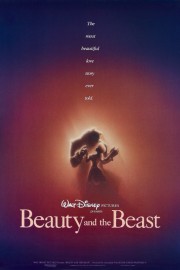Beauty and the Beast
How much of “Beauty and the Beast’s” reputation comes from its own merits, or from the fact that it was the first animated film ever nominated for the Best Picture Oscar? I saw it, officially, for the first time during an IMAX re-release in the early 2000s, but didn’t really love it. It was very good, but I wasn’t blown away by it like others. Now, with Disney’s live-action version about to be released, revisiting this was a must.
More so than the songs by the late Howard Ashman and Alan Menken, more so than some of Disney’s most beautiful hand-drawn animation, augmented (for the first time) with CGI flourishes, and more so than the comedic supporting cast, the MVP of the film is screenwriter Linda Woolverton, who brings together the work of several writers in Disney’s story department for this bold interpretation of the story by Jeanne-Marie Leprince de Beaumont. It is her script that develops the character of Belle (voiced by Paige O’Hara) as a smart, well-read heroine with the ability to handle herself in a difficult situation, whether she’s being held captive by the Beast (Robbie Benson) or being pursued by Gaston (Richard White), the village’s arrogant hunter. She is a natural follow-up to “The Little Mermaid’s” Ariel, and one of the most engaging Disney “princesses” of all-time, with Rapunzel in “Tangled” and Anna in “Frozen” being her descendants. By the time she repels Gaston’s advances the first time, we completely are on her side, with her love of her father (Rex Everhart) showing the type of person she is. This was a new type of independence that had a Disney princess not really requiring a man’s love to be a complete character, and I don’t know that I really appreciated that the first time I saw it. Much of the credit goes to Woolverton’s script, but the truth is, it’s also a credit to Disney, who didn’t just follow the formula that made “Mermaid” so successful, and allowed “Beast” to stand on its own.
The story by de Beaumont had been told before by French director Jean Cocteau in the 1940s, but it’s easy to see why Disney’s version had the impact it did. For the first time in a while, the animators, led by Gary Trousdale & Kirk Wise, were not afraid to create truly dark and disturbing imagery to tell their story- this is a Grimms fairy tale of a movie, at times, the same way the “Night on Bald Mountain” sequence is in “Fantasia” and some of the scenes in “Snow White” are. Meanwhile, the character of the Beast is one of the scariest, most imposing characters ever designed for a Disney film, one that is genuinely terrifying to the point that, when her father, and later her, find themselves in the Beast’s castle, we feel real concern for their lives. Thankfully, they have allies in the magically-transformed help in the castle: the worried clock, Cogsworth (David Ogden Stiers); the charismatic candles, Lumiere (Jerry Orbach); the sweet old Ms. Potts (Angela Lansbury) and her son Chip (Bradley Pierce), among others. They not only provide Belle, and the audience, with much entertainment, but also serve as an emotional guide to the Beast, trying to refine him so that he and Belle fall in love, and subsequently break the curse he had placed upon him all those years ago.
Time makes it easier to sometime appreciate a film’s greatness more than a quick reaction when the film is first seen. That’s especially true when a film has a reputation like “Beauty and the Beast,” and has become, what I call, an “official classic.” Those are the films whose greatness has become so ingrained in its identity, people just take it for granted that, indeed, it is great. I think it’s safe to say that over 26 years, “Beauty and the Beast” has made it into that company. Thankfully, all one has to do is to watch any given scene of this film, and understand the power and imagination Disney brought to the table in telling this tale as old as time.










